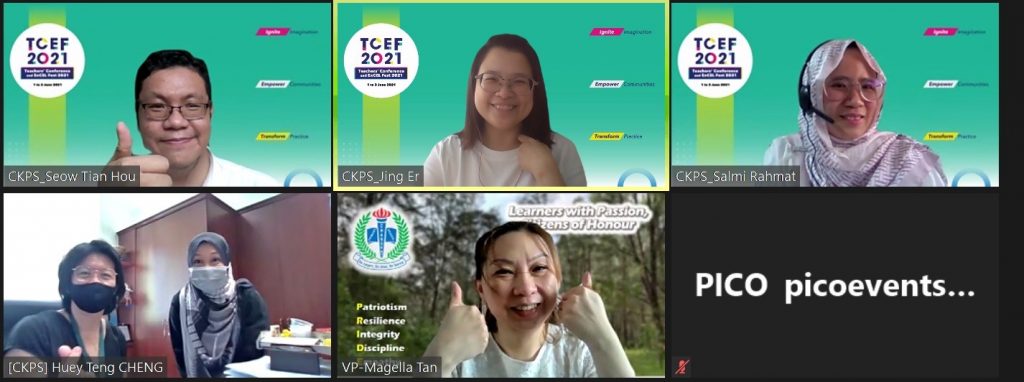Why Singapore’s English Teachers Should Embrace Singlish, Not Fight It
Is it time for Singaporean educators to embrace Singlish as a legitimate learning tool? What the Research […]
Read More
From fighting climate change to advocating sustainable lifestyles – these are pressing environmental problems that affect our daily lives. At Changkat Primary School, it is common sight to see students conducting research on these environmental issues and building automated solutions to solve them. Students are eager to bring these global problems into their classrooms and embark on a quest to find effective solutions. Three teachers from the school share with us how their students do it at the recent Teachers’ Conference and Excel Fest.

Teachers from Changkat Primary School discuss how the Applied Learning Programme is integrated into the school’s curriculum.
Launched in 2019, the Applied Learning Programme (ALP) at Changkat Primary School (CKPS) focuses on the theme ECO@CKPS, which aims to develop students with an empathic understanding towards issues relating to the earth and environment through design thinking and computational thinking.
To help unlock a students’ potential to create and innovate by applying the knowledge they have learnt in the classrooms to real-world problems, the programme adopts the Stanford’s Design Thinking Model. It has five different stages of design thinking: Empathize, Define (the problem), Ideate, Prototype and Test.
This model involves students conducting research and interviews to gain an empathetic understanding of actual environmental issues they experienced in their daily lives. They then define the problem through a group discussion and engage in an ideation process to brainstorm for solutions. At the last stage of the project, students will collaborate to design and build a prototype before putting their product to test. The prototype-test cycle will repeat until students produce their desired outcomes.
On the other hand, computational thinking refers to the ability to break down complex problems into smaller problems with the help of computers in automating the task. Students can develop this form of thinking during coding lessons as part of the ALP programme.
Subject Head of Innovation Mr Seow Tian Hou explains, “During the coding lessons, we will show students how to create functions and how they can simplify the codes by creating repeated loops using logic statements. In a way, when a student is trying to simplify the codes, they are engaging in one form of computational thinking.”
The integration of design thinking and computational thinking helps create a structured and systematic approach for young students to gain the confidence they need to create human-centric innovations for complex real-world problems.
“We could see that the students are enjoying themselves as they can solve problems in the real-world environment with the knowledge that they gain in the classroom. This is where the joy of learning comes in.”
– Mdm Salmi Rahmat, on how ALP programmes encourage the joy of learning among students
Although the ALP curriculum focuses largely on technology and coding, the programme also incorporates a myriad of other subjects into one project task. Subjects such as Science, Mathematics and Art are also integrated into the ALP curriculum.
Science is integrated when students explore the topic of sustainability, and conduct investigations and experiments to test their ideas. Mathematics is incorporated when students deal with logical and rational thinking as they embark on their project tasks. Lastly, Arts is infused into the curriculum in the form of craftwork when the students are creating their prototypes.
Additionally, the ALP curriculum is an effective way to help students see the connection between the knowledge they learn during classes and real-world applications. “We could see that the students are enjoying themselves as they can solve problems in the real-world environment with the knowledge that they gain in the classroom. This is where the joy of learning comes in,” Head of Science Department Mdm Salmi Rahmat shares.
Since the inception of the ALP programme, CKPS students have produced plenty of creative and innovative ideas such as solutions to mitigate food wastage and designing automated toilet bowl flusher.
Citing a recent example, Ms Peh Jing Er shares that, “when the COVID-19 pandemic heavily disrupted the operations of the schools, many groups of students came up with the idea of automated soap or sanitizer dispenser and automated water tap saver.” This shows that the students are aware of the challenges around them, and they are empowered enough to propose solutions to mitigate the school’s operational challenges.
CKPS’ commitment to its mission of nurturing creative thinkers and problem solvers extends to almost all its learners. Coding lessons begins for students as young as Primary 1 and the programme continues until the Primary 5 level.
Head of ICT Department Ms Peh shares, “Who knows? Perhaps one of these brilliant ideas that our children came up with might be adopted for a school-wide, or even a nationwide implementation. What is important is that we germinate the seeds of design thinking in our students so they will always want to make our world a better place for everyone.”